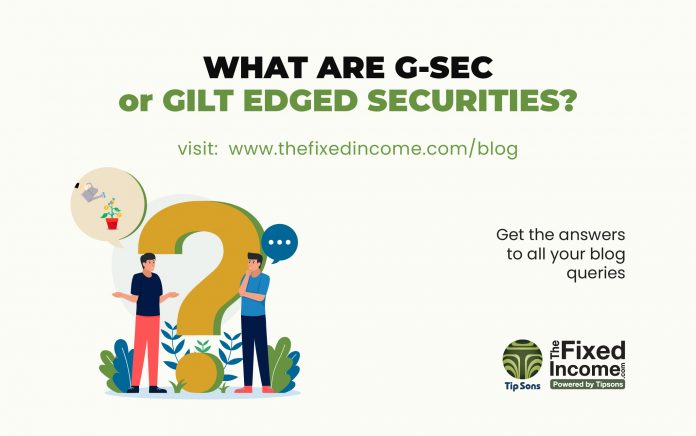Government Securities: Safest and Diversified Investments
We often ask ourselves, “which is the safest investment option?” Or “which investment vehicle would provide me a guaranteed return?” And then we also hear about “diversification” or “don’t put all the eggs in one basket”!
Well, we do have an answer for all of these: Government Securities!
Types of Government Securities: Short-Term and Long-Term Instruments
Issued by the central and state governments, and also referred to as ‘Gilt edged’ securities, Government Securities are considered as the safest investment. Additionally, they are apt to diversify an investment portfolio as they offer minimal to zero exposure to risk, and guaranteed returns. Unless of course the government goes kaput!
Government securities also play a pivotal role in the RBIs monetary policy and liquidity management in the economy. Along with that, the interest rates are benchmarked to the return being offered on government securities.
Broadly, government securities can be bucketed into short-term and long-term:
Short term instruments: Short term debt instruments, also termed as money market instruments as they trade on the money market, and are only issued by the central government. There are two main short term government securities:
Treasury Bills / T-Bills: are issued only by the central government in India, and are zero coupon securities, issued at a discount to the face value and redeemed at par, for a duration of 91 days, 182 days, and/or 364 days
Cash Management Bills (CMBs): issued in 2010 to meet the cash flow mismatch and are zero-coupon securities, issued at a discount to the face value and redeemed at par, for a duration of less than 91 days only
Long term instruments: Issued by both, central and state governments and tradable on the debt market. Long-term government securities can be bucketed into the following types:
Government Bonds / Dated Securities / G-Sec: Coupon bearing securities with a face value of Rs.100, issued for a fixed term of 5 to 40 years. Within G-Sec securities, following types of securities are issued:
○ Sovereign Gold Bonds (SGBs): debt securities issued in units of grams of Gold, with a fixed semi-annual coupon payment, and redemption of units in cash on maturity
○ Fixed Rate Bonds (FRBs): First issued in India in September 1995, offers a
fixed coupon rate for the term of investment (till maturity), and principal paid on maturity
○ Floating Rate Bonds: offers a variable coupon rate, re-set at pre-announced intervals, and principal paid on maturity. Principal to be redeemed on maturity, early redemption only available for certain senior citizens. The coupon payment is reset semi-annually in Jan and July, and will be pegged to the prevailing National Certificates Rate (NSC) with a spread of 35 basis points
○ Zero-Coupon Bonds: as the name suggests, these are zero coupon bonds, issued at a discount to the face value and redeemed at par
○ Capital Indexed Bonds: issued in 1997 and later replaced by inflation indexed bonds (IIBs) in 2013, principal is safeguarded by linking it to an accepted rate of inflation, with fixed coupon payments
○ Inflation Indexed Bonds (IIBs): first issued in India in June 2013, both principal and coupon payments are safeguarded by linking them to an accepted rate of inflation. On redemption, the principal amount will be multiplied by the index ratio (and referred to as ‘adjusted principal’), and whichever is higher – adjusted principal or the face value – will get paid to the
2 investor. Fixed coupon payments will be made on the adjusted principal as opposed to the face value, hence safeguarded against inflation
○ Bonds with Call/Put Options: issued with a feature where the issuer has an option to buy back (call option), and/or the investor has an option to sell the bond (put option) back to the issuer during the course of the investment term
○ Special securities: issued by the Government from time to time to meet various purposes. For e.g. ‘special zero coupon bond’ specifically issued to Punjab and Sind bank to inject capital in the bank. These were similar to Zero-coupon bonds with an exception that they were issued at par and redeemed at par only as the intent was to infuse capital in the bank, hence zero coupon and zero gain
○ STRIPS (Separate Trading of Registered Interest and Principal of Securities): zero coupon bonds, created out of an existing security, and redeemed on maturity. This enables an investor to hold and trade interest and principal component of eligible G-Sec securities as two separate securities
State Development Loans (SDLs): are state government securities issued with a coupon bearing, a fixed term and face value of Rs.100, semi-annual interest payment, with principal repaid on maturity.
An informed decision is always a good practice when doing investment planning. Abreast yourself about the risk and returns associated with various investment options, and diversify your investment portfolio!
And a share of the pie does belong to government securities!
























